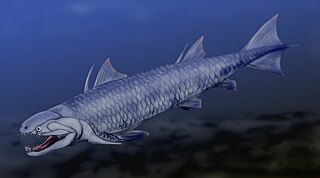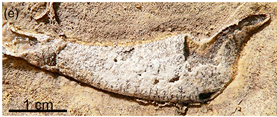
Chondrichthyes is a class of jawed fish that contains the cartilaginous fish or chondrichthyans, which all have skeletons primarily composed of cartilage. They can be contrasted with the Osteichthyes or bony fish, which have skeletons primarily composed of bone tissue. Chondrichthyes are aquatic vertebrates with paired fins, paired nares, placoid scales, conus arteriosus in the heart, and a lack of opercula and swim bladders. Within the infraphylum Gnathostomata, cartilaginous fishes are distinct from all other jawed vertebrates.

Placoderms are vertebrate animals of the class Placodermi, an extinct group of prehistoric fish known from Paleozoic fossils during the Silurian and the Devonian periods. While their endoskeletons are mainly cartilaginous, their head and thorax were covered by articulated armoured plates, and the rest of the body was scaled or naked depending on the species.

Psarolepis is a genus of extinct bony fish which lived around 397 to 418 million years ago. Fossils of Psarolepis have been found mainly in South China and described by paleontologist Xiaobo Yu in 1998. It is not known certainly in which group Psarolepis belongs, but paleontologists agree that it probably is a basal genus and seems to be close to the common ancestor of lobe-finned and ray-finned fishes. In 2001, paleontologist John A. Long compared Psarolepis with onychodontiform fishes and refer to their relationships.

Lunaspis is an extinct genus of armor-plated petalichthyid placoderm fish that lived in shallow marine environments of the Early Devonian period, from approximately 409.1 to 402.5 million year ago. Fossils have been found in Germany, China and Australia. There are three different identified species of within the genus Lunaspis: L. broilii, L. heroldi, and L. prumiensis.

Onychodus is a genus of prehistoric lobe-finned fish which lived during the Devonian Period. It is one of the best known of the group of onychodontiform fishes. Scattered fossil teeth of Onychodus were first described from Ohio in 1857 by John Strong Newberry. Other species were found in Australia, England, Norway and Germany showing that it had a widespread range.
Walter Robert Gross was a German palaeontologist. During his career, Gross made important studies on prehistoric fishes. He was the graduate mentor to paleontologists Hans-Peter Schultze and Klaus Fahlbusch. The genus Grossopterus was named in Gross' honor by fellow paleontologist Leif Størmer.

Osteolepididae is a family of primitive, fish-like tetrapodomorphs that lived during the Devonian period. The family is generally thought to be paraphyletic, with the traits that characterise the family being widely distributed among basal tetrapodomorphs and other osteichthyans. Some of the genera historically placed in Osteolepididae have more recently been assigned to the family Megalichthyidae, which appears to be a monophyletic group.
Amadeodipterus is an extinct genus of lungfish which lived during the Devonian period. Fossils have been found in Central Australia.
Ganopristodus is an extinct genus of prehistoric sarcopterygian or lobe-finned fish from the Devonian.
Iowadipterus is an extinct genus of prehistoric sarcopterygian or lobe-finned fish.
Muranjilepis is an extinct genus of tetrapodomorphs from the Early Devonian of Australia.
Westollrhynchus is an extinct genus of prehistoric sarcopterygians or lobe-finned fish containing only one recognized species, Westrollrhynchus lehmanni.
Dialipina is an extinct genus of prehistoric marine bony fish from the Early Devonian. It contains two species, both known from the high Arctic of Asia and North America. It was initially thought to be and sometimes still is treated as an early, basal actinopterygian, but recent phylogenetic analyses suggest that it may instead be a stem-osteichthyan.

Rhadinichthys is an extinct genus of prehistoric bony fish. It is known from several species that lived in the Late Devonian epoch, the Carboniferous period and the Cisuralian epoch in what is now Europe, South Africa, and North and South America. Some isolated scales from the Cisuralian of Europe were also referred to this genus.

Ligulalepis is an extinct genus of stem-osteichthyans which lived from the Silurian to the Early Devonian. Ligulalepis was first described from isolated scales found in the Taemas-Wee jasper limestones of New South Wales by Hans-Peter Schultze (1968) and further material described by Burrow (1994). A nearly complete skull found in the same general location was described in Nature by Basden et al. (2000) claiming the genus was closely related to basal ray-finned fishes (Actinopterygii). In 2015 Flinders University student Benedict King found a more complete new skull of this genus which was formally described by Clement et al. (2018), showing Ligulalepis to be on the stem of all osteichthyans.

Edenopteron is a genus of large tristichopterid fish from the Late Devonian (Famennian) of what is now southeastern Australia. It is known from a single specimen of a single species, E. keithcrooki, described in 2013.
Janusiscus schultzei is an extinct gnathostome vertebrate dating from the Early Devonian period in Siberia, approximately 415 million years ago. It may be the sister group of the last common ancestor of Chondrichthyes or Osteichthyes. This makes J. schultzei a sister species to all living jawed vertebrates. The species name is in honor of Hans-Peter Schultze; the genus named after Janus, the Roman god of duality.

Gogoselachus is an extinct genus of cartilaginous fish known from the late Devonian of Australia. It is one of the earliest well-preserved Devonian chondrichthyans, as much more of the fish than just teeth and scales were preserved. This rare preservation reveals some unique discoveries about the evolution of the cartilage that was inside later cartilaginous fish such as sharks, rays, and chimaeras.














